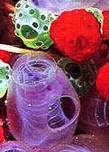
(larvacean) |

(solitary sea squirts) |
Phylum CHORDATA
(tree from Tree of Life; traits from
|

(lancelet) |

(larvacean) |

(solitary sea squirts) |
Phylum CHORDATA
(tree from Tree of Life; traits from
|

(lancelet) |
===========1======================= CEPHALOCHORDATA (lancelets)
|
| ====== Cl. Larvacea (appendicularians)
| ===3= UROCHORDATA =======|
| | (=Tunicata) | === Cl. Thaliacea (salps, doliolids, pyrosomes)
<<=C==| | =4=|
| | === Cl. Ascidiacea (sea squirts)
=2==|
| ====== Cyclostomata (jawless hagfish & lampreys)
======5= VERTEBRATA =====|
(=Craniata) ====== Gnathostomata (jawed vertebrates)
Back to Zool 250 tree for animal phyla or Deuterostomia.
TRAITS SUPPORTING EACH CLADE (** plesiomorphic- a primitive state, not unique to clade) AND HIGHER TAXA:
|
b) endostyle (thyroid gland in vertebrates) c) notochord d) dorsal hollow nerve cord e) dorsal, somatic post-anal tail** f) segmented myomeres g) protocoelic nephridium (=axial complex) lost h) metacoel lost (i.e., coelom not tripartite b) unusual protonephridia-like nephridia c) muscular notochord extends into rostrum b) loss of 6 HOX genes |
b) outer acellular (cellulose) cuticle c) 2 (Larvacea) or 1 (Ascidiacea) exhalent siphons or spiracles from pharynx d) U-shaped gut e) gill-slits no longer U-shaped f) reversible direction to heart beat g) nephridia & coelom absent h) hermaphroditic i) primitive sperm morphology j) strict cell fate determination k) destruction of HOX gene cluster & loss of Hox7 & Hox8 (David & Mooi Evo Devo 2014 5:22) b) full endoskeleton with cranium c) anterior end of neural tube enlarged as brain d) multilayered (stratified) epithelium e) blood vessels lined with endothelium f) glomerular kidney g) polar bodies from oral pole |